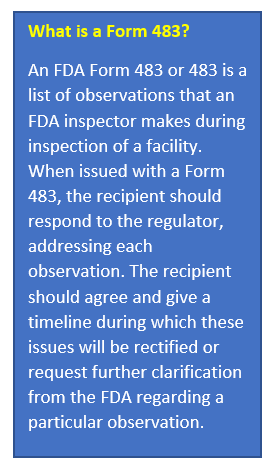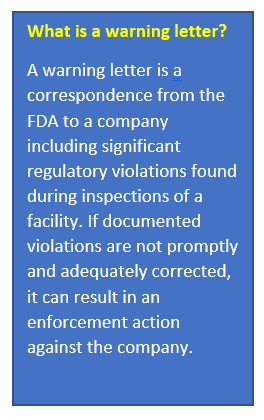7 Best Practices FDA Regulated Companies Should Follow for Hassle-Free Inspections
- Do an assessment of the firm’s capability to design and manufacture the device as claimed in the PMA
- Confirm whether the firm's Quality System is in compliance with 21 CFR 820, Quality System Regulation
- Consider the extent to which the firm has established a formal QS program
- Check whether the approved design is properly translated into specifications via process validation
- District FDA offices have a work plan by month. This plan chooses those firms that have not been inspected in a while
- Some inspections maybe directed by the centers at the FDA – the Center for Food Safety and Applied Nutrition or Center for Drug Evaluation and Research may decide to inspect certain firms
- If there have been product complaints or recalls, there’s sure to be an FDA inspection scheduled of the responsible firm
- If there have been changes to GMP regulations in a particular area, then the FDA may inspect firms to ensure they are in compliance
- Another reason is a ‘For Cause Inspection’ – this is the most serious inspection, instigated by the FDA because they believe there’s been serious non-compliance by a firm
- A search warrant based on probable cause or
- An administrative warrant that has been issued by the agency or
- Statutory authority to inspect issued by the agency
- Review the Form 482 handed over by the FDA inspector
- Check the credentials of the FDA inspector (his or her badge)
- Ask the inspector to wait in the reception area while the FDA liaison is contacted and the liaison arrives
- When the FDA inspector asks for documents, it is best to keep the following in mind:
- Only respond to specific document requests
- If the inspector asks for documents and does not give any limitations, then ask for the limitation. For example, if the inspector asks for complaints for a catheter, then ask which model and which time frame. The inspector is not going to ask for all the complaints for all kinds of catheters, but would specify a time period for the complaint records.
- Only give the inspector the documents which s/he has requested.
- The firm should not give documents other than requested. For example, when asked for complaints about a device made in July, do not ask if they want the August complaint records as well.
- What documents were given to the inspector
- What sections of the firm were inspected
- Any possible 483 observations gleaned from conversations with the inspector. The FDA liaison can ask the inspector for this information
Reduce the risk of form 483 observations by Implementing tried and tested procedures during the FDA inspection process.

When the FDA inspector calls, even the most experienced professional can lose confidence and make the inspection process more painful and confrontational than it needs to be. Firms are very often unsure of how to deal with the FDA inspector’s requests and can complicate matters by becoming too antagonistic or go in the opposite direction and volunteer more information than necessary.
This article discusses different types of FDA inspections and the seven best practices that FDA regulated companies can follow in order to ensure a trouble-free FDA inspection process that reduces the risk of multiple and unnecessary Form 483 observations.
As manufacturing gets increasingly complex with introduction of new technologies and operating procedures, the regulations have become complex in their scope as well. Companies now not only have to worry about plants they own, but contract manufacturers, foreign facilities and the headache of ensuring that suppliers/vendors are compliant with regulations
Types of FDA inspections
There are four types of FDA inspections: Routine The routine inspection follows the Quality System Inspection Technique (QSIT) program.
Pre-Approval Inspection for PMA Devices
This inspection will:
This inspection follows the guidance outlined in the program guide, Medical Device Premarket Approval Inspection.


Warning Letter Follow-Up Inspection
This inspection takes place after the FDA receives a response to a warning letter. It is done to ensure that corrective actions the firm has taken or is going to take and stated in the response have been implemented.
For Cause Inspection
This inspection is undertaken for a particular, specific reason. For example, if a firm distributes promotional literature that includes indications of use different from those stated in submissions to the Agency, the FDA may inspect the firm for this particular reason
Factors that Lead to An FDA Inspection
Inspections can be hard to predict – some firms are inspected regularly, but some are not inspected at all.
The reasons why the FDA inspects a firm may include:
Legal Basis for FDA Entering a Facility
The FDA can enter and inspect a facility at a reasonable time, within reasonable limits and in a reasonable manner, according to the Section 704 of the Food, Drug & Cosmetic Act.
In order for the FDA to inspect a facility, inspectors should have:
7 Best Practices Firms Must Follow for Successful FDA Inspections
Train Receptionist to Interact with FDA Inspector
The receptionist is the first person to interact with the FDA inspector and therefore should do the following:
Acknowledge the inspector
Escort the Inspector
The FDA liaison should escort the FDA inspector to the room that acts as a base for inspections. This room, most industry experts agree, should preferably near the bathroom so as to limit his or her wandering around the facility without a liaison present.
Offer FDA Inspector Facility Tour
The FDA liaison is not required to give the Inspector a facility tour. But since he/she will anyway ask to see any part of facility during the course of inspection, the liaison can ask the inspector if he would like to take a tour first.
This can show that the firm is open about its operations and has nothing to hide.
Ensure the FDA Inspector is Not Left Alone
It is a best practice to ensure that the FDA inspector is not left alone unless they are reviewing records or other documentation. But if they are moving around the facility, they should always be accompanied by the FDA liaison or other firm representative. This is especially true when they are speaking to workers/employees in the facility
Get Specifics for Document Requests
Prepare a Daily Summary
The FDA liaison should prepare a daily summary of the FDA inspection. This should include:
This summary should be distributed among the management so they are aware of the developments that occurred during that day’s inspection and ensure they are up to date and ready to address queries during discussions with the FDA inspectors at the end of the inspection.
Correct Observations During Long Inspections
While some inspections may be over in three days, some may take up to two weeks with the FDA inspector coming in only for part of the day for the inspection. This can work to the advantage of the firm being inspected. The longer the FDA inspections, the easier it is to correct any observations that have cropped up during the process.
If there is an obvious error in a procedure (for example, a reference) then the SOP document change can be done and pushed through during the inspection itself. This will
How compliance training can help?
ComplianceOnline provides a wide range of training courses for different roles across FDA regulated industries such as pharma, biotech, medical devices and clinical research. Our courses are available as live webinars, training recordings and in-person seminars. We also offer customized training courses developed in conjunction with organizations that wish to train large groups of their employees.
If you need customized training courses or specialist FDA regulatory consulting services, please contact us through email [email protected] or call us at this
toll-free number: +1-888-717-2436.






